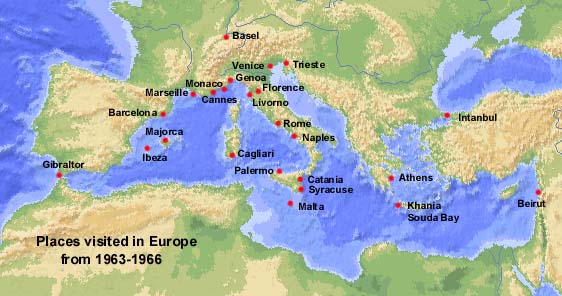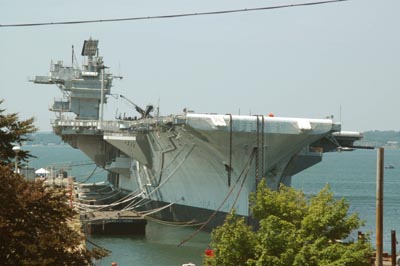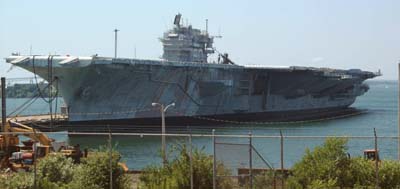

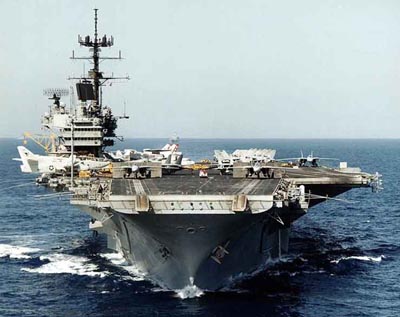
I scored very high on the then "general classification
test" (GCT) with a 73 out of a possible 75, and with some prior
ROTC training at Peekskill Military Academy was appointed
Recruit Petty Officer in Charge (RPOC) of the recruit company.
After a hospitalized bout of pneumonia, I was relieved of duty
and joined a succeeding recruit company as just a recruit. In this
new recruit company I scored the highest in academic performance
for the training provided.
After boot camp, I was sent to further training as a "yeoman" at
a training base in Bainbridge, Maryland. However, I did not succeed
at the school for failure to pass the 30 word per minute typing
requirement and was ordered for duty "with the fleet."
I was ordered to report to the USS SARATOGA (CVA-60) which was then
undergoing a renovation and upgrade at the Norfolk Naval Shipyard
at Norfolk, Virginia. SARATOGA was then one of about a dozen main
attack carriers of the fleet - equipped to respond to nuclear war.
It was 70,000 tons and carried a crew of 5,000 with its airgroup
aboard. The ship was in drydock and I was assigned to the 1st Division,
a boatswain's division responsible for the forecastle, anchoring and
chain equipment.
After some time working with the anchoring and chain locker, I was
assigned to maintain the Captain's ladder, presumably because I
would know how to civilly behave when the Captain passed by.
Bye and bye in the "chow line" or line for meals, I met another
sailor who worked in the Air Intelligence Office of the ship, who
mentioned they were looking for another seaman for their office.
With my test scores and background it was arranged that I be
transferred to the Operations Division and the Air Intelligence Office.
This required me to successfully pass the background investigations
required to secure a TOP SECRET security clearance.
Part of the SARATOGA's refit involved the Air Intelligence Office.
The Navy introduced computers to the process and installed UNIVAC
computers for the first time on a capital ship. I eventually became the
yeoman (read secretary) for the new intelligence officer of the ship
who was a WWII experienced aviator and soon made Commander upon his
arrival for duty. This officer and I occupied a small office which
contained the Top Secret mission folders of the aircraft which
would eventually join us as we "deployed" for duty with the fleet.
Other spaces of the office contained a briefing and map room, the
UNIVACS, and data processing machines. The whole operation was now
designated the Integrated Operational Intelligence Center (IOIC)
instead of "air intelligence office." The new IOIC staff headed by
a commander included four other officers and about 15 other sailors
including new computer ratings and photo interpreters,
We constantly received a vast array of classified material from the
Office of Naval Intelligence and the CIA to support both the ship's
"area of action" and "area of interest" as it was termed. The former
was the furthest distance of our aircraft from the ship, and the
latter included the former plus the fact that the ship itself could
sail to different areas of the sea. Thus deployed with the 6th Fleet
we needed to have intelligence of the entire Mediterranean, as well
as Europe, North Africa, and the Middle East. I received and filed
this material.
Above my head was a small safe which required two officers to open to
authenticate a prepositioned war message in the event the President
authorized an all out retaliation for nuclear war. Heady business.
While in this duty in October 1962 the "Cuban Missile Crisis" broke
out, and
while SARATOGA was still in drydock, I was sent to hand-deliver via
chauffered car, a message to CINCLANT (Commander in Chief, Atlantic Fleet).
The fleet was presumeably under radio silence, and while I did not
know the contents of the message I presume it involved SARATOGA's "sitrep"
(situation report) and the ship's ability to respond to the crisis. I do
know that the work to get SARATOGA ready for sea increased dramatically
thereafter.
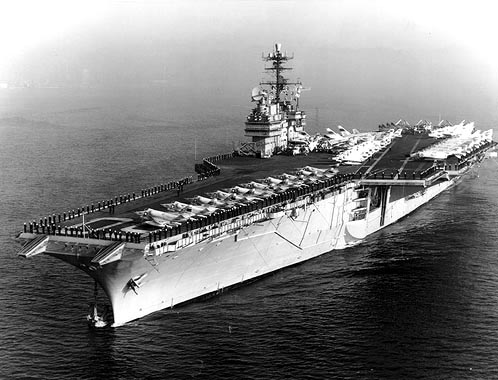
By late November the work was done and we arrived at our homeport, Mayport
Florida, down the St.Johns river from Jacksonville. After taking on supplies
we put to sea, had our "airgroup" join us, and became part of the task
forces opposing the Russian merchant ships that had already turned around
from Caribbean waters. However, we were officially "part of the action" of
the "Cuban Missile Crisis" and awarded an "Armed Forces Expeditionary Medal"
which subsequently in later life entitled me to join the
Veterans of Foreign Wars (VFW).
John F. Kennedy was President and commander-in-chief at the time, and
Robert McNamara was his Secretary of Defense. McNamara thought
aircraft carriers were obsolete in view of routine Russian overflights
of the fleet in all oceans by their long-range "Bison" bombers.
After the Cuban crisis, things returned to normal and we prepared for a
routine deployment to the Mediterranean and the 6th Fleet. However the Navy
wanted to prove to McNamara that a carrier could not be detected at sea
So on our sail east to the Mediterranean from Florida, instead of sailing
the logical "great circle", and shortest route, we were ordered by CINCLANT
to sail along the 30th parallel of latitude instead. This brought us
to the southern boundary of Morrocco from whence we headed north through
the straits of Gibraltor into the Mediterranean. During the trans-Atlantic
passage, we had interceptors on the catapults ready to quickly launch if a
Russian appeared overhead. None did. But we did launch a fighter once
to intercept a civilian airliner who was unidentified to us.
Our deployment to the 6th Fleet in the Mediteranean was an illuminating
joy to me. I had learned French in high school. Our second port of visit
after Palermo, Sicily was Marseille, France. For some odd reason our visit
was the first of a major American warship since World War II. When we
arrived, the "powers that be" decided that the ship would be open to
visits by the French civilian population. The problem no one had thought
about was who of the ship's company could speak French? It turned out no one
but me, a seaman in the Air Intelligence Office. I offered that I was not
really fluent in French, but I would try.
And so it came to pass, I was the unofficial "tour guide" for French
civilians visiting the USS SARATOGA on her visit to Marseille, France.
How I managed in fractured French I cannot imagine to this day. But no
one could correct me, so there. (I can't imagine what the French thought.)
From there it was a delightful tour of the Mediterranean at taxpayer's
expense for me. Gibraltor, Istanbul, Venice, Genoa, Malta, Cannes,
Pireaus and other ports.

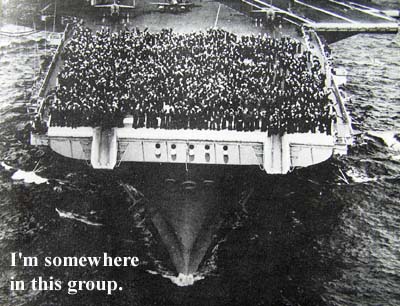
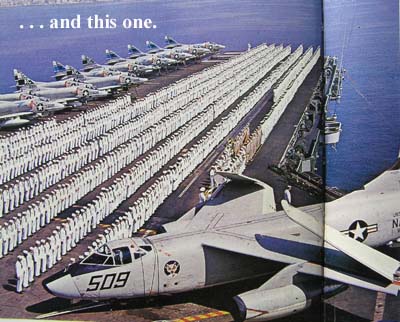
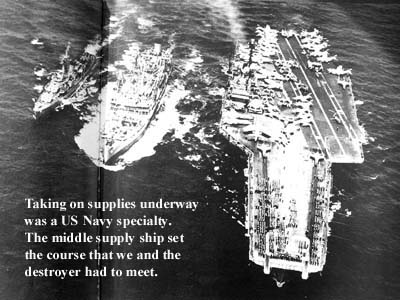
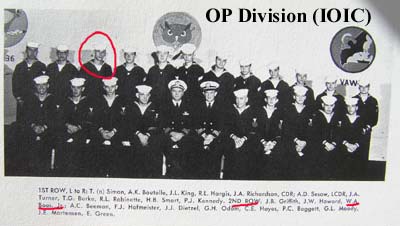
Unusual events involved riding out a hurricane off the Florida coast
and having to go to `generel quarters' one night off the island of Corsica.
The ship and airgroup were conducting a `live ordnance expenditure'drill
at a NATO bombing range there during the day, and were recovering planes
at night. Unfortunately a plane landed before the previous one was clear
causing an explosion and fire, and taking the lives of five pilots and
four flight deck sailors. The additional problem was that live bombs were
all over the flight deck, elevators, and hanger deck. The fires spread to
all three areas posing a danger to the ship itself. They got it under
control - but for about 40 minutes it was nerve-racking.
After our 6th Fleet deployment we sailed home to Mayport, but my job
allowed me to continually look at general classified and unclassified
fleet messages. One day a routine message arrived from fleet headquarters
advising that the USS TALAHATICHIE COUNTY (AVB-2) based in Naples, Italy
was seeking personnel for "preferred sea duty". Already knowing French,
and with a chance to learn Italian, I asked the boss if I could apply.
He approved, and fleet approved me for transfer to that ship and duty in
Naples, Italy. This was sometime in late 1963. After a 2-week leave period,
I flew to Italy and reported on-board the TALLAHATCHIE COUNTY (AVB-2)
It was originally built as LST-1154 during the last months of WWII and was
one of only two driven by steam turbines instead of diesels. It was now
designated an "Advanced Aviation base ship" permanently home ported in
Naples, Italy. It reported to Commander, Fleet Air Mediterranean and not
the U.S. 6th Fleet. It was the only ship of its type in the Navy.
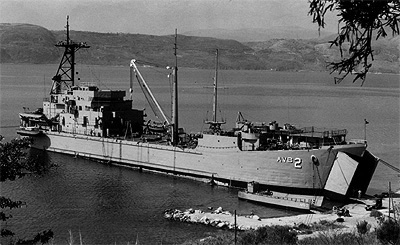
Still a seaman (E-3) I was assigned to the supply division. I no longer
needed a security clearance. My goal was to learn Italian. Since SARATOGA
visited Naples, I returned to a particular cafe where the owner was a
deported Italian-American from Providence, Rhode Island and I reminded
him of my visit and asked where one might rent a room or apartment in
the city. He vaguely remembered me, and referred me to another "deported"
Mafiosi who rented me a room in his dwelling.
Since TALLAHATICHIE COUNTY was not part of the 6th Fleet and under
Commander, Fleet Air Mediteranean, we could wear civilian clothes ashore.
So, it cost me about $30/month for a room, and I found a tailor to make
suits for $38 a suit, I had some clothes tailored in the local style.
Since the ship stayed mostly in port, it was basically a 9-5 job. When
I didn't have the "watch", I submerged myself in the Neapolitan life to
the extent I was able. Finally, I decided to go to the Berlitz school to
learn Italian. They didn't know what to do with an American who wanted to
learn Italian, as they were staffed to teach Italians to learn English,
French, German or whatever.
But they found a teacher to teach me Italian. He was a remarkable man
named Mario del Giudice, an Italian journalist and columist for the local
newspaper "IL MATTINO." Our "class" was one-on-one, he and me. After about
three weeks, he confided to me, "You don't need to pay Berlitz any longer,
I'll personally see to your learning." He did, thereafter at no expense to
me. In short, we clicked and I joined a select group of international folk
in Naples under his wing. He conducted tours of the countryside for and with
us and wrote about our adventures in IL MATTINO. My Italian improved greatly,
and I can say at age 70, that it's better than my French. There are many
memories of Italy and Naples, including the possibility that I might have a
child there.
Suffice to say, my Italian language competence made me important to the
supply officer's negotiation of contracts in various foreign ports of the
TALLAHATCHIE COUNTY'S travels thereafter.
One memorable visit was to the port of Beirut. This was sometime in 1965.
As always, we contracted for fresh dairy, fruit and vegetables with local
port "ship chandlers", purveyors to merchant and naval visiting ships.
In Beirut, I a mere 23 year-old petty officer, was confronted by a 60+
year-old ship chandler who produced a letter from his wallet that was given
to his grandfather by the Burser of Teddy Roosevelt's "Great White Fleet".
After seeing what was obviously a historic recommendation for his firm,
I gave him the contract for what we needed. (I wrote the contracts, the
supply officer, on my recommendation, made them legal). This was Beirut's
glorious days as the "Paris of the East" (1965) and he added, "Mr. Boas, if
you needed $500,000.00 in gold in 30-minutes, I could have it for you."
Enough said about Beirut at that time. I had a delightful time in Beirut
because I spoke French, as Lebanon was once a French colony.
The TALLAHATCHIE COUNTY did leave Naples for cruises and excercises.
We sailed to Malta, Venice, Crete, the Balerics, Cannes, Trieste, and
a few other ports. We spent two summers at Souda Bay, Crete. There I
met the local ship chandler and influential leader of the local community
whose cousin was a minister of the current Greek government.
As an AVB and converted WWII LST - we were an "advanced aviation base
ship" (AVB) - the only one in the Navy. We were designed and provisioned
to support an anti-submarine squadron in the Mediterranean at any one
of 70 abandoned runways on the periphery of Europe and North Africa.
On board we had SeaBees, and complete parts and support for a squadron
of P3 ORION anti-submarine aircraft based in Sigonella, Sicily. If the
"big nuclear war" started, we were equipped to set up an airfield as an
alternative to the fixed based at Sigonella.
In 1965 I finally made petty officer and stood in-port watches with the
Officer of the Deck and kept the ship's log. In Naples, Russian merchant
ships used to call and one was tied up at the same dock as we were. One
watch, three Russians walked over to our gangway and asked if we had any
movies to loan them. From my days in the intelligence business, I saw
an opportunity and asked the command if we could accomodate them. We did,
also receiving an invitation to visit their ship. Again, the command
approved and I and another petty officer went aboard the Russian ship and
enjoyed some vodka and comaraderie. One of the Russians opened his closet
to get something and I noticed the two stripes and diamond of a Russian
naval lieutenant - confirming to me that the Russian merchant service was
integral with the Russian Navy.
In 1964 the Freedoms Foundation at Valley Forge solicited essays on the
subject "My Vote, Freedom's Privilege" from members of the armed forces
for their annual awards program. In a sucinct 130 words I stated my view
and submitted it. Months later, I received from the Chief of Naval
personnel, via the chain of command, that I'd won a "Goerge Washington
Honor Medal," offering congratulations and that it be presented to me
with `appropriate ceremony.' So when Commander, Fleet Air Mediterranean
inspected the ship, he made the presentation with crew assembled.

As a regular Navy enlistee, I was extended for about three months during
the "Vietnam era" and eventually was discharged at Brooklyn, NY in May
of 1966. Thus ended my naval service.
